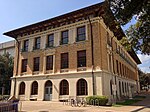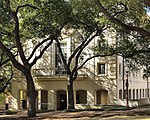Harry Ransom Center

The Harry Ransom Center (until 1983 the Humanities Research Center) is an archive, library and museum at the University of Texas at Austin, specializing in the collection of literary and cultural artifacts from the Americas and Europe for the purpose of advancing the study of the arts and humanities. The Ransom Center houses 36 million literary manuscripts, one million rare books, five million photographs, and more than 100,000 works of art.The Center has a reading room for scholars and galleries which display rotating exhibitions of works and objects from the collections. In the 2015–2016 academic year, the center hosted nearly 6,000 research visits resulting in the publication of over 145 books.
Excerpt from the Wikipedia article Harry Ransom Center (License: CC BY-SA 3.0, Authors, Images).Harry Ransom Center
West 21st Street, Austin
Geographical coordinates (GPS) Address External links Nearby Places Show on map
Geographical coordinates (GPS)
| Latitude | Longitude |
|---|---|
| N 30.2843 ° | E -97.7412 ° |
Address
Harry Ransom Center
West 21st Street 300
78705 Austin
Texas, United States
Open on Google Maps











